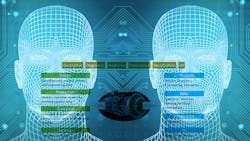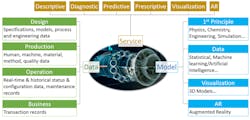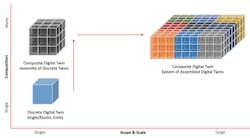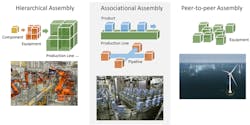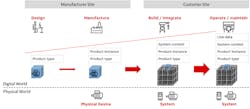A Short Introduction to Digital Twins
The Industrial Internet Consortium (IIC) defines a digital twin as a digital representation of an entity, including attributes and behaviors, sufficient to meet the requirements of a set of use cases. In this context, the entity in the definition of digital representation is typically an asset, process or system.
Digital twin information includes combinations of the following categories:
- Physics-based models and data
- Analytical models and data
- Time series data and historians
- Transactional data
- Master data
- Visual models
- Computations
What follows is an IIC perspective on what digital twins are and some of their technical characteristics.
Designing Digital Twins
A digital twin comprises data, computational models (hereafter just “models”) and service interfaces, such as an object in an object-oriented programing language that has member data, methods and interfaces.
Data. A digital twin contains data about its real-world object that are required by the models to represent and understand the states and behaviors of the object. In many cases, it may consist of data in the full lifecycle of the object or—in the case of equipment—consist of data during the design phase (specifications, design models, production process and engineering data); production phase (data about workers, production equipment, material and parts, production methods and quality assurance); operation phase (installation and configuration data, real-time and historical state and status, as well as maintenance records); and even end-of-life procedural data. It may also contain business data, such as transaction records.
Models. A digital twin contains computational or analytic models that are required to describe, understand and predict the real-world object’s operational states and behaviors, as well as models that are used to prescribe actions based on business logic and objectives about the corresponding object. These models may include models based on physics or chemistry, engineering or simulation models, data models based on statistics, machine learning and artificial intelligence (AI). It may also include 3D models and augmented reality models for aiding human understanding of the operational states or behaviors of real-world objects.
Service (interface). A digital twin contains a set of service interfaces for industrial applications or other digital twins to access its data and invoke its capabilities.
With a common approach, we can construct a digital twin for equipment from its constituent component digital twins; a production line digital twin from the constituent equipment digital twins; and a factory digital twin from its production line constituent digital twins—just like with their counterparts in the real world.
Relying on a digital representation enabled by the digital twin, we can enable a host of smart industrial applications to run operations in the real world, optimally improving these operations.
Relationships Among Digital Twins in Systems
The level of abstraction of a digital twin is such that it is sufficient for the requirements of a specific application or use case. A discrete digital twin is a single entity that provides value without needing to be broken down further. Assembling discrete digital twins to create a composite digital twin is shown in Fig. 3 as a vertical expansion that describes the increase in composition from a single to many entities.
As the scale and scope of a composite digital twin increase, it may expand horizontally from a composite assembly to a more complex composite system. The coloring in Fig. 3 shows how a composite digital twin system is made up of multiple composite digital twin assemblies.
The relationships between digital twins in an assembly are typically:
- Hierarchical: Just like their real-world counterparts, a set of component digital twins can be assembled into an equipment digital twin, a set of equipment digital twins can be assembled into a production line digital twin, a set of production line digital twins can be assembled into a factory digital twin—and so on.
- Associational: There are associations between digital twins, similar to their real-world counterparts. A gas pipeline digital twin is associated with its gas production and consumption equipment digital twins.
- Peer-to-peer: The peer-to-peer relationship is observed in a group of equipment of same or similar types which perform the same or similar functions. The total effect of all the equipment is the simple sum of the outcome produced by each piece of equipment.
Digital Twin in an Entity Lifecycle
A digital twin is a solution to the information silo problem: The information about an entity is usually scattered across multiple information sources, which are developed and maintained by different organizations.
Figure 5 shows how digital twins can be used to tackle the information silo problem. The digital twin of the product is a means of, and the single interface to, accessing its lifecycle information. There are also semantic relationships between the digital twins just as there are in the real world. Failure to establish these relationships would leave the disconnected digital twin as an information silo to itself. Since the information comes from different sources, at different points in time and in different formats, establishing such relations in an automatic way is one of the major challenges in designing digital twins.
Many of the information silo problems can be addressed by offering a single entry-point to access the lifecycle information of entities and by maintaining relations among the information within one digital twin and across multiple digital twins.
Technical Aspects of a Digital Twin
A digital twin consists of a number of technical aspects, and Fig. 6 addresses some of the most common technical considerations when deploying digital twins.
- Information modelling: The core part of digital twin is information which is related to different lifecycle phases of the underlying entity.
- Information population: Information for digital twins originate from various sources. Some may be maintained inside the digital twins.
- Information synchronization: It is necessary to keep digital twins in sync with the original information sources.
- APIs: Digital twins interact with other components. To facilitate these interactions, various APIs must be in place.
- Connectivity: The key enabler for interactions with and among digital twins is their ability to connect.
- Deployment: Digital twins can be deployed on a spectrum from the edge to the cloud based on the requirements of the application.
- Interoperability: As different vendors offer their own digital twin solutions, it is necessary for digital twins to interact with each other in an interoperable way toward fulfilling the overall functionality of the target system.
Outlook
There will be a proliferation of digital twins over the next few years according to industry analysts. It is important to have a common understanding of what digital twins are, how they deliver value and how we can create these twins in a trustworthy manner. The IIC provides vendor-agnostic guidance through white papers, frameworks and testbeds on new and emerging technologies, such as digital twins.
Within the IIC, the Digital Twin Interoperability Task Group is actively working on practical guidance on the use and application of digital twins. Current and future work includes frameworks for digital twin architecture, security, interoperability and user experience.
This article was submitted by IIC and prepared by Pieter van Schalkwyk, CEO, XMPro; Dr. Somayeh Malakuti, senior scientist, ABB Corporate Research, Germany; and Shi-Wan Lin, CTO, Yo-i Information Technology, Ltd. For more information, visit www.iiconsortium.org.
